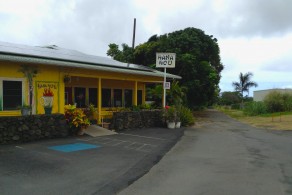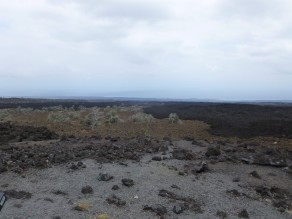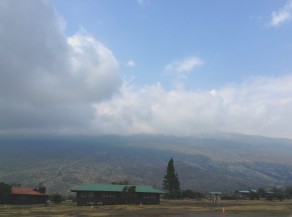Hawai’i Day Four part three: Back to Hilo
href=”https://www.mcelhinneyart.com/jlmcelhinney/wp-content/uploads/2015/07/P1010791-e1438184534201.jpg”>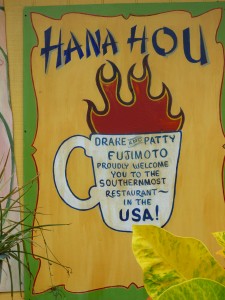
Facing a choice of routes, we decided to not retrace our steps but instead return to Hilo via the Saddle Road crossing the northern end of the island between the peaks of Mauna Loa and Mauna Kea. Driving up to the ridge above Punalu’u, we turned left onto Route 19 and proceeded to Na’ālehu, population 866. The name of the settlement in Hawaiian means “volcano ashes”. Trees line the street passing by a cluster of civic buildings and shops on the left side of which we found a brightly painted single-story building advertising itself as the southernmost restaurant in the United States. The Samoans might have something to say about that if they were inclined to split hairs. The open plan of Hana Hou restaurant was similar to many local eateries on the Big Island; lunch counter and table seating, no air conditioning, fans whirring overhead.
The diner fusion cuisine included fish tacos, pulled pork and salad all served as part of the dish I selected. The management and wait-staff were predominantly native. Sensitive to the resentment that can sometimes be expressed by people of color towards European-Americans, based on the many abuses suffered by their ancestors at the hands of whites, I found indigenous Hawaiians to be outwardly friendly and meticulously polite. An older generation might have remembered, or heard from their elders the story of how mainlanders arrived first to spread Christianity and were followed by sugar planters who at a time when White Supremacy was at its peak overthrew the Kingdom of Hawai’i. The Hawaiian term Ha’ole literally means “without breath” and is said to be derived from the first contact with mariners sailing with Captain Cook, who were ignorant of the practice of exhaling while pressing the nose and brow against that of another as the common form of greeting. Bows and handshakes delivered by Brits were interpreted by the locals as mistrust or hauteur. The last day of school leading into summer vacation is known in some places as “Kill Haole Day”, some native kids allegedly heckle and assault their light-skinned classmates. The majority population on the Big Island is Hawaiian, and my sense is that the majority of those harboring hostility toward whites regard them as inconvenient outsiders or necessary evils. Continuing our journey the road led west, across the landward end of South Point. We were disappointed to no have visited the green sand beach at Papakolea but our vehicle would not have stood up to the rough condition of the road leading to the water’s edge. The slope of Mauna Loa climbed into the clouds on our right. Black lava flows punctuated sunburnt grasslands while out to our left spread the wide blue Pacific.
Moving northward toward Kona, the vegetation quickly changed from mountainous savannah to forests and fields as we entered coffee country. Kona coffee is highly renowned and the prices reflect it. A pound of roasted ground or whole beans can set you back sixty dollars. The highway climbed to a thousand feet above the ocean as we moved from the slopes of Mauna Loa onto those of a smaller active volcano named Hualālai. By all reports this is the most worrisome of the five major Big Island volcanoes, and the one most likely to erupt one day. Of course it looms above an enclave of pricey resorts while million-dollar homes pepper its flanks.
A precipitous drop from the shelf of land traversed by the road descended to a shoreline of white breakers crashing against the black rim of a green coastal plain a mile or two in width. We stopped for coffee at a roadside café a few miles below the town of Captain Cook that overlooked the site where the explorer had been killed in a needless dust-up with irate locals. Kathie is maniacal about her coffee and was enchanted beyond words by the heady brew she was served alfresco. The establishment appeared to have once been a service station. The white block building backed up onto a modest lanai with a concrete floor and corrugated steel roof. We debated making a detour down to the coastline where the Kailua-Kona resorts are located, but ditched the plan when we encountered the same bumper-to-bumper beach traffic one finds everywhere else. Instead we veered off the main road on to Route 180 and headed for Holualoa village, where I was to deliver a talk one week hence. The winding two-lane road followed torturous curves bereft of guard-rails. Driveways seemed to plunge and soar up from the roadway’s negligible wooded shoulders at impossible grades, possible only in such a climate but undoubtedly vexing for any car with a standard transmission. The village was a concatenation of shops and galleries, a B&B and an inn priced at opposite ends of the market. Unsure of our ETA in Hilo, we elected to carry on. 180 ended at a t-intersection where we turned right (north) onto 190—the main road between Kailua-Kona and Waimea in the heart of Hawaii’s cattle country. Within a few miles forest and vegetation gave was to arid conditions. We passed to the left almost two thousand feel below the Kona airport and then Kekaha Kai Beach, the coastline stretching off toward North Point and the green Kohala Highlands. Rolling grassy hills punctuated by dark lava flows and extinct spatter cones flanked the highway as off to the right a gathering of clouds shrouded the peak of Mauna Kea. The exit for Hilo arrived suddenly. A right turn from the road to Waimea put us on Highway 200, locally known as Saddle Road. The right of way varied from road cuts through deep lava beds to crossing grassy hilltops. Passing a cluster of tan Quonset huts to our right we approached the massive form of Mauna Kea, coming to the entrance of an eponymous state park located at its southern base.
Gullied slopes soared into the clouds. The buildings resembled a KMC type configuration—a quasi-military facility. New parking lots and recreational facilities were under construction, or at least construction had begun. No one was at work on them. The park headquarters were closed, but we made us of the restrooms that were located in a separate building.
A couple of Hawaiian men took a coffee break in a cable company van. A family of mainland tourists relaxed at a picnic table.
As we proceeded east we passed a monument erected next to an extinct spatter-cone; a stone altar festooned with ceremonial offerings, leaves and bundles, and presumed it to have been erected by native activists objecting to the construction of a massive new telescope on the summit of Mauna Kea. Crossing through more lava fields we skirted the northwestern margins of Mauna Loa and were suddenly met with a tangle of vegetation, then forest, then rain. The joke is that on the Big Island one can pass from one climate zone to another simply by crossing the road. Returning to Hilo Route 200 descends dramatically to become Wainuenue Avenue, along which are located many of the K12 public schools and the athletic fields. We returned to the Pakalana, unpacked the car and went to Pineapples for dinner.
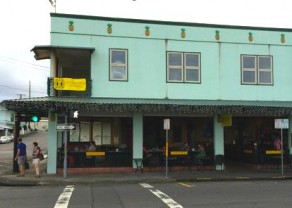
The open-air bistro on the first floor of a low-rise flatiron building on the corner of Mamo, Keawe and Kilauea serves a young, lively crowd. I suspect few tourists were among them, the cruise ship having left port the day before. Our waiter was a friendly twenty-something effeminite man who vaguely resembled The Artist Formerly Known as Prince.
So are we having a drink, yaah? He asked in a creaky voice.
We ordered a couple of cocktails
Ditcha look at the specials, yaah?
They were on a blackboard. We hadn’t. So he told us what they were. We ordered.
Menu and service were above par. It was nice to find a place with an urban vibe.
We paid our check and walked around downtown Hilo before heading back to our quarters. Bums were asleep in the doorway of nearly every shop. Like so many homeless people we had seen in Berlin, many of them possessed a musical instrument and a dog. Two shirtless men had staked out opposite sides of the step of the Tsunami Museum. One of them had a backpack. The other one had a blanket.
At nine o’clock Cronie’s sports bar was getting ready to shut down for the night. Some New Yorkers might have bristled at the midwestern timetable followed by Hilo restaurateurs, or by the strong undercurrent of churchgoing culture. In a stroke of genius our landlord had decided that the best place for the television was on top of the microwave oven. We never turned on it, or the microwave.
In the course of one day we had stood at the smoldering rim of an active volcano, completed a circuit of an island slightly larger than the state of Connecticut, passed through three or four climate zones and had been served dinner by an AFKAP lookalike. Nothing on television could top that.
